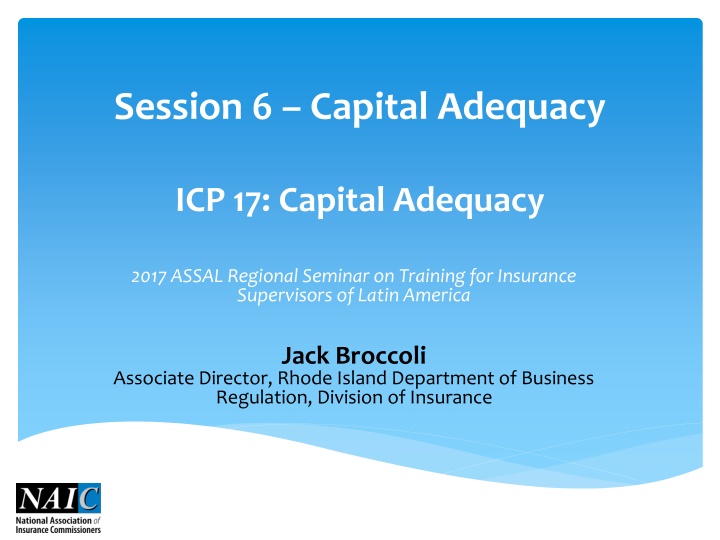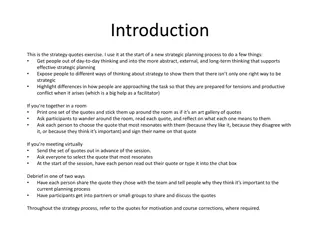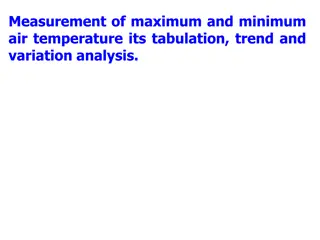
Capital Adequacy Requirements in Insurance Supervision
Explore the essential aspects of capital adequacy in insurance supervision, including the objectives of establishing capital requirements, overview of Risk-Based Capital (RBC), typical causes of insolvencies, and detailed insights into capital requirements in the US. The discussion also touches on the covariance formula and its role in adjusting the total RBC for remote risks.
Download Presentation

Please find below an Image/Link to download the presentation.
The content on the website is provided AS IS for your information and personal use only. It may not be sold, licensed, or shared on other websites without obtaining consent from the author. If you encounter any issues during the download, it is possible that the publisher has removed the file from their server.
You are allowed to download the files provided on this website for personal or commercial use, subject to the condition that they are used lawfully. All files are the property of their respective owners.
The content on the website is provided AS IS for your information and personal use only. It may not be sold, licensed, or shared on other websites without obtaining consent from the author.
E N D
Presentation Transcript
Session 6 Capital Adequacy ICP 17: Capital Adequacy 2017 ASSAL Regional Seminar on Training for Insurance Supervisors of Latin America Jack Broccoli Associate Director, Rhode Island Department of Business Regulation, Division of Insurance
ICP 17 Objectives ICP 17 Capital Adequacy The supervisor establishes capital adequacy requirements for solvency purposes so that insurers can absorb significant unforeseen losses and to provide for degrees of supervisory intervention.
Overview of RBC RBC is used to identify a poorly capitalized insurer given its overall business operations in consideration of its size and risk profile. Accounts for a company s risk exposure Adjusts minimum capital and surplus Reflects unique risks inherent in operating an insurance company
7 Typical Causes of Insolvencies 1. 2. Deficient Reserves (P&C & Health) Rapid Growth/Inadequate Pricing (P&C & Health) 50%+ 3. 4. 5. 6. Catastrophic Losses (Property) 7. Reinsurance Problems (Property) Fraud Investment Problems (Generally Life) Problems with Affiliates
Capital Requirements in the US AGGREGATED P&C RBC DATA YR2016 (Including Catastrophe Risk) # OF COMPANIES FILED RBC AUTHORIZED CONTROL LEVEL RBC (AFTER DIVERSIFICATION) 2,263 138,674,310,776 Total R0A (R0A - asset risk-subsidiary insurance companies) Total R1A (R1A - asset risk-fixed income) Total R2A (R2A - asset risk-equity) Total R3 (R3- asset risk-credit) Total R3A (R3A - asset risk-credit) Total R4 (R4 - underwriting risk - reserves) Total R5A (R5A - Underwriting Risk - net written premium) Total Rcat (R6 for Earthquake, R7 for Hurricane) 53,372,325,366 8,245,138,135 104,755,558,433 15,209,538,138 9,488,603,942 108,983,784,131 69,209,100,248 59,104,956,618
Covariance Formula What is the covariance adjustment? Reduces aggregate amount of RBC Authorized Control Level recognizing that the risk is remote that the surplus will be simultaneously impaired by reductions in all risk. The calculations (before CAT Risk of R6 & R7): Property/Casualty = R0 + (R1)2+(R2)2+(R3)2+(R4)2+(R5)2 The Covariance adjustment is used to discount the total RBC Before Covariance because the RBC amounts for the individual components when simply added together, overstate the true risk. It is assumed that not all events for which RBC is required would occur at the same time.
Ability to Absorb Significant Unforeseen Losses- P&C Net Income/Loss Trends Net Income Return on Revenue 80 14% 70 12% 60 10% 50 8% (in billions) 40 6% 30 4% 20 2% 10 - - (10) (2%) '00 '01 '02 '03 '04 '05 '06 '07 '08 '09 '10 '11 '12 '13 '14 '15 '16 7
US Catastrophe Losses (Insured Losses) Hurricane Isaac Hurricane Sandy (Northeast) Severe Weather (Midwest, Ohio Valley) U.S. Drought Drought (South, Southwest) Hurricane Irene Severe Spring Weather (Southeast, Midwest, Ohio Valley) 40 37.0 36.2 35 30.3 California Drought Hurricane Matthew (Southeast Coast) Louisiana Flooding Severe Weather (South) Texas Flooding Texas Hail Storm Wildfires Hurricane Gustav Hurricane Ike Midwest Flooding Severe Weather (Midwest) U.S. Drought 30 25 21.0 20 (in Billions) 15.8 15.7 15.4 15 13.4 11.8 10 7.7 5 0 '07 '08 '09 '10 '11 '12 '13 '14 '15 '16 Sources: National Centers for Environmental Information and Munich RE 8
Policyholders Surplus (Equity) 800 731.3 700 9 600 500 400 (in billions) 328.6 300 200 123% Growth Since 2000 100 - 00 01 02 03 04 05 06 07 08 09 10 11 12 13 14 15 16 9
Degrees of Supervisory Intervention AGGREGATED P&C RBC DATA Year End '2016 YR2016 (Including Catastrophe Risk) TOTAL CO'S AT A LEVEL TREND TEST LEVEL 1 19 COMPANY ACTION LEVEL REGULATORY ACTION LEVEL AUTHORIZED CONTROL LEVEL MANDATORY CONTROL LEVEL TOTAL CO'S AT AN ACTION LEVEL TOTAL CO'S % OF ACTION LEVEL COMPANIES 1 2 3 4 14 7 5 14 40 2263 1.77%
The RBC Ratio The Company s actual capital held (Total Adjusted Capital) is compared the minimum level of capital (Authorized Control Level) Total Adjusted Capital/Authorized Control Level = RBC Ratio There are 5 levels of action that a company can trigger: No Action RBC Ratio greater than 200% Company Action Level RBC Ratio is between 150% and 200% Regulatory Action Level RBC Ratio is between 100% and 150% Authorized Control Level RBC Ratio is between 70% and 100% Mandatory Control Level RBC Ratio is below 70%
The RBC Ratio Company Action Level-In the event of a Company Action Level Event, the insurer shall prepare and submit to the commissioner an RBC Plan which shall: (1)Identify the conditions which contribute to the Company Action Level Event; (2)Contain proposals of corrective actions which the insurer intends to take and would be expected to result in the elimination of the Company Action Level Event;
The RBC Ratio Company Action Level- (3) Provide projections of the insurer s financial results in the current year and at least the four (4) succeeding years, both in the absence of proposed corrective actions and giving effect to the proposed corrective actions, including projections of statutory operating income, net income, capital and surplus. (The projections for both new and renewal business might include separate projections for each major line of business and separately identify each significant income, expense and benefit component);
The RBC Ratio Company Action Level- (4) Identify the key assumptions impacting the insurer s projections and the sensitivity of the projections to the assumptions; and (5) Identify the quality of, and problems associated with, the insurer s business, including but not limited to its assets, anticipated business growth and associated surplus strain, extraordinary exposure to risk, mix of business and use of reinsurance, if any, in each case.
ICP 17 The regulatory capital requirements are established in an open and transparent process, and the objectives of the regulatory capital requirements and the bases on which they are determined are explicit. In determining regulatory capital requirements, the supervisor allows a set of standardised and, if appropriate, other approved more tailored approaches such as the use of (partial or full) internal models.





















